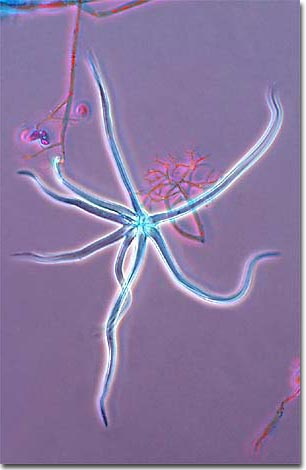Phase Contrast Image Gallery
Tobacco Blue Mold
Blue mold affects only tobacco plants and is a local, regional, and continental problem. It is caused by the fungus Peronospora tabacina, which rapidly produces tiny spores that are ejected into the air and spread by air currents. As evidenced by this micrograph, combining phase contrast microscopy with classical histological staining techniques often yields enhancement of cellular features.

In recent years, biologists have begun using meteorological tools to track clouds of these spores traveling on the wind over the Caribbean, Latin America, the continental United States, and Canada. This information is used to predict outbreaks of blue mold, giving tobacco growers an opportunity to protect and treat their crops.
The blue mold fungus produces spores that are the result of both sexual and vegetative reproduction. Resting spores, or oospores, are produced through sexual reproduction (fusion of female and male gametes) and are believed to be more involved with long term survival of the species. Sporangiospores are produced vegetatively (i.e., the fungus makes clones of itself) and can be made by the millions within hours after a tobacco plant is infected.
BACK TO THE PHASE CONTRAST GALLERY
